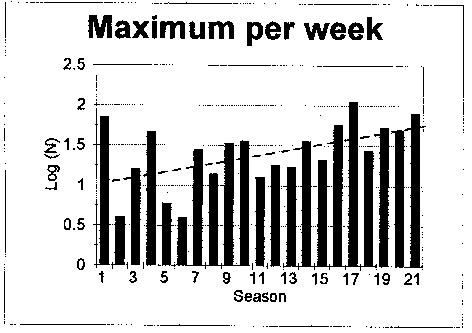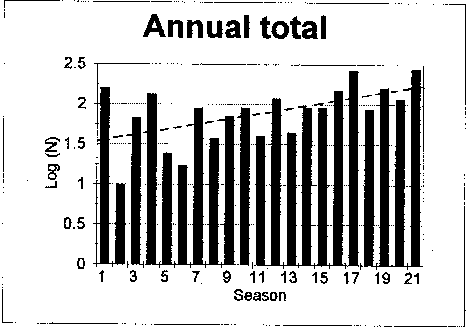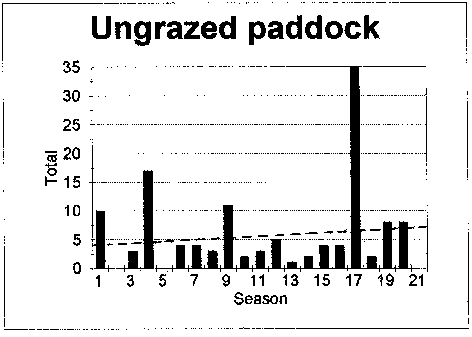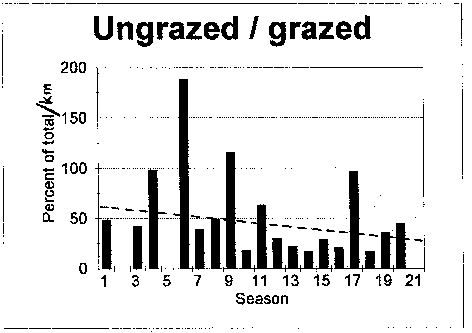GLOW-WORMS AT WINDMILL HILL RESERVE, NORTH LITTLETON
1982-2002
Terry Knight
In 1979 Windmill Hill was purchased by
the Worcestershire Wildlife Trust for a nature reserve.
It is a Site of Special Scientific Interest situated in
open arable country and is readily accessible to the
public from its entrance on the south side of the B4510
at SP 071476.
The site consists of a west facing escarpment 900 metres
long having a thin band of White Lias limestone at its
crest below which there is about 5 metre thickness of
Rhaetic beds on top of Mercian Mudstone. The topsoil
derived from this is calcareous and clayey. In summer it
bakes hard and shrinks to form rough hexagonal areas,
typically 800 mm along the slope and 600 mm down,
surrounded by a crack up to 50 mm wide and 600 mm deep.
These cracks provide daytime refuges for glow-worms.
A bridleway runs along the top of the escarpment and
along the bottom is a strip of mature hawthorn scrub 20
to 25 metres in width. The land between consists of
grassland dominated by Tor-grass and is generally about
60 metres wide. This grassland has been enclosed to give
five end-to-end paddocks, the northern one and the
southern three being grazed by sheep from time to time,
the other remaining un-grazed. Scattered mature hawthorn
trees occur in the paddocks and young hawthorn is
constantly invading but this is removed by hand on a four
or five year rotation in order to prevent the grass being
shaded out. The reserve has a rich mollusc fauna to
support the established colony of glow-worms.
The glow-worm colony extends onto the banks and verges of
the adjacent B4510. Further small outlying colonies exist
at 200 metres east of the north end and 150 metres east
of the south end. Other than this the nearest known
significant colony is 2.3 kilometres away to the south
east plus a smaller colony 2 kilometres away to the
south, both on man-made habitat.
|
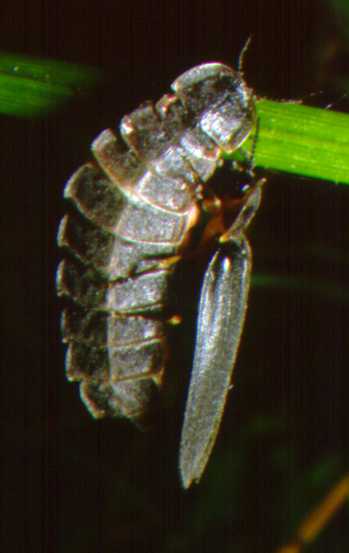 |
In 1982 when a butterfly transect was started it was also decided
to carry out a similar survey of glow-worms. The method adopted
was to commence the walk between 10.45 and 11.00 pm and proceed
along 700 metres of bridleway and 760 metres through the centre
of the paddocks recording all glowing females seen from the path.
This has been done weekly each year during the glowing season (June
to August).
Both the maximum weekly count and the total of weekly counts in a
season have tended to increase since recording began (see graphs).
Regression analysis indicates that over the 21 seasons the
average rate of increase is 8 percent per annum. The largest
weekly count in a paddock occurred on 16th July 1998 when 52
females were seen in 215 metres across the north paddock.
However, the numbers seen in the un-grazed paddock have generally
been less than in the grazed paddocks and the average rate of
increase is smaller. From regression analysis the increase seems
to be less than a quarter of that in the other paddocks. This has
led to the factor (total per km in the un-grazed paddock) I (total
per km in the grazed paddocks) falling from 63% to 30% during the
21 years (see graphs).
The difference between the un-grazed and grazed paddocks might be
accounted for in part by the females being easier to see in the
shorter grass. However, this would not explain the sustained
difference in rate of increase over the long time interval. It is
suggested from experiments at Aston Rowant National Nature
Reserve that grazing affects glow-worm numbers, too little or too
much being detrimental (Tyler 1994).
It is probably more than sixty years since previous owners of the
site employed regular grazing to manage it. Since then they have
just controlled scrub invasion by irregular burning of the grass.
When the Trust took it over it was decided to re-introduce
grazing. To prepare for this, perhaps unwisely, it was decided to
carry out large scale burns of the grass during the early spring
of 1981 and 1982. However, burning is considered highly damaging
to slower moving animals, eg molluscs (Crofts and Jefferson 1999).
In 1982 the glow-worm counts were relatively high but in 1983 (season
2) they were the lowest on record followed by the next lowest
records in 1986 and 1987.
It would appear that the records at Windmill Hill support the
view that controlled grazing is beneficial, but burning
detrimental, to glow-worms. An explanation of the findings might
be as follows. The irregular burnings over forty years or so
reduced the population below that in pre-burning days. The large
scale burnings over the two winters in the early 1980's reduced
this even further by almost eliminating one generation. After
this no significant burning took place and the population in the
un-gazed paddock slowly recovered while in the grazed paddocks
the recovery has been much quicker. The recovery is still
continuing and it will be interesting to see how long this takes
and what the stable population will be.
REFERENCES
TYLER, JOHN 1994 Glow-worms. Tyler-Scagell
CROFTS, A AND JEFFERSON, R G (Eds) 1999 The Lowland Grassland
Management Handbook, 2nd Edition. English Nature &The
Wildlife Trusts

